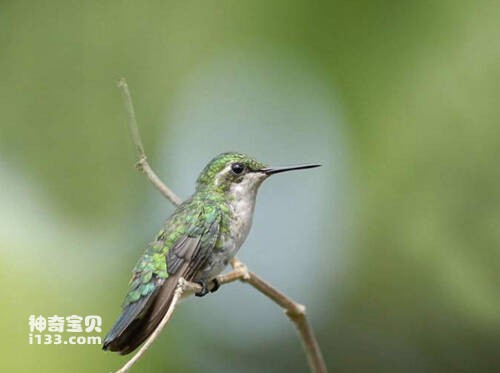Chlorostilbon bracei
IUCN
LCBasic Information
Scientific classification
- name:Chlorostilbon bracei
- Scientific Name:Chlorostilbon bracei,Brace's Emerald
- Outline:Climbing birds
- Family:
Vital signs
- length:9.5cm
- Weight:No textual research information is available
- lifetime:No textual research information is available
Feature
It's an extinct hummingbird endemic to New Providence Island in the Bahamas.
Distribution and Habitat
New Providence Island, Bahamas.
Appearance
The bird is about 9.5 cm long, with wings 11.4 cm long and a tail 2.7 cm long. Their beaks are black and slightly curved down, with a conical tip. The feet are black. The back is coppery green with a golden sheen. The head is colored like the back, but without the golden luster. White spots behind the eyes. The throat is blue-black and the belly feathers are green with gray tips. The wings are purple. The flight feathers are green, and the perianal feathers are gray with pale cinnamon edges.
Details
Chlorostilbon bracei, foreign name Brace' s Emerald, whose specific habit is unknown.

In 1877, a specimen of a male Bushwhi hummingbird was found 4.8 km off Nassau, Bahamas, with a badly injured throat and was stored at the Smithsonian Institution in Washington, DC. However, the specimen was not noticed until 1880, when it was listed as a synonym for the Cuban Emerald hummingbird. It was not until the 1930s that a comparison was made between the Bouilleri hummingbird and the Cuban Bouilleri Hummingbird, and in 1945 it was listed as a subspecies of the Cuban Bouilleri hummingbird. This bird is smaller than the Cuban bird and has a longer beak and a different feather color.
In 1982, the fossil remains of three Pleistocene hummingbird species were discovered in caves on New Providence Island, including the Bahamian Forest Star hummingbird, the Cuban Green hummingbird, and later the actual Green hummingbird. This proves that the Bouilleri hummingbird is a new species that has been living on New Providence Island since the Pleistocene. They probably lost their habitat due to human disturbance, such as the discovery of agriculture, and eventually became extinct at the end of the 19th century.
Protect wild animals and eliminate wild meat.
Maintaining ecological balance is everyone's responsibility!








